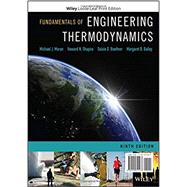Fundamentals of Engineering Thermodynamics, 9th Edition sets the standard for teaching students how to be effective problem solvers. Real-world applications emphasize the relevance of thermodynamics principles to some of the most critical problems and issues of today, including topics related to energy and the environment, biomedical/bioengineering, and emerging technologies.









